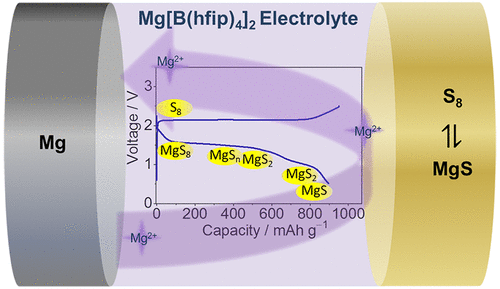当前位置:
X-MOL 学术
›
ACS Energy Lett.
›
论文详情
Our official English website, www.x-mol.net, welcomes your
feedback! (Note: you will need to create a separate account there.)
Toward Highly Reversible Magnesium–Sulfur Batteries with Efficient and Practical Mg[B(hfip)4]2 Electrolyte
ACS Energy Letters ( IF 19.3 ) Pub Date : 2018-07-25 00:00:00 , DOI: 10.1021/acsenergylett.8b01061 Zhirong Zhao-Karger 1 , Runyu Liu 2 , Wenxu Dai 2 , Zhenyou Li 1 , Thomas Diemant 3 , B. P. Vinayan 1 , Christian Bonatto Minella 1 , Xingwen Yu 4 , Arumugam Manthiram 4 , R. Jürgen Behm 1, 3 , Mario Ruben 2, 5 , Maximilian Fichtner 1, 2
ACS Energy Letters ( IF 19.3 ) Pub Date : 2018-07-25 00:00:00 , DOI: 10.1021/acsenergylett.8b01061 Zhirong Zhao-Karger 1 , Runyu Liu 2 , Wenxu Dai 2 , Zhenyou Li 1 , Thomas Diemant 3 , B. P. Vinayan 1 , Christian Bonatto Minella 1 , Xingwen Yu 4 , Arumugam Manthiram 4 , R. Jürgen Behm 1, 3 , Mario Ruben 2, 5 , Maximilian Fichtner 1, 2
Affiliation

|
The rechargeable magnesium (Mg) battery has been considered a promising candidate for future battery generations due to unique advantages of the Mg metal anode. The combination of Mg with a sulfur cathode is one of the attractive electrochemical energy storage systems that use safe, low-cost, and sustainable materials and could potentially provide a high energy density. To develop a suitable electrolyte remains the key challenge for realization of a magnesium sulfur (Mg–S) battery. Herein, we demonstrate that magnesium tetrakis(hexafluoroisopropyloxy) borate Mg[B(hfip)4]2 (hfip = OC(H)(CF3)2) satisfies a multitude of requirements for an efficient and practical electrolyte, including high anodic stability (>4.5 V), high ionic conductivity (∼11 mS cm–1), and excellent long-term Mg cycling stability with a low polarization. Insightful mechanistic studies verify the reversible redox processes of Mg–S chemistry by utilizing Mg[B(hfip)4]2 electroylte and also unveil the origin of the voltage hysteresis in Mg–S batteries.
中文翻译:

迈向高效,实用的Mg [B(hfip)4 ] 2电解质的高可逆镁硫电池
由于镁金属阳极的独特优势,可再充电镁(Mg)电池被认为是未来电池的有前途的候选者。Mg与硫阴极的结合是使用安全,低成本和可持续材料的有吸引力的电化学储能系统之一,并可能提供高能量密度。开发合适的电解质仍然是实现镁硫(Mg–S)电池的关键挑战。在此,我们证明四(六氟异丙氧基)硼酸镁Mg [B(hfip)4 ] 2(hfip = OC(H)(CF 3)2)满足了高效实用电解液的多种要求,包括高阳极稳定性(> 4.5 V),高离子电导率(〜11 mS cm –1)和出色的长期Mg循环稳定性以及低极化性。深入的机理研究通过利用Mg [B(hfip)4 ] 2电解质验证了Mg-S化学的可逆氧化还原过程,并且揭示了Mg-S电池电压滞后的起因。
更新日期:2018-07-25
中文翻译:

迈向高效,实用的Mg [B(hfip)4 ] 2电解质的高可逆镁硫电池
由于镁金属阳极的独特优势,可再充电镁(Mg)电池被认为是未来电池的有前途的候选者。Mg与硫阴极的结合是使用安全,低成本和可持续材料的有吸引力的电化学储能系统之一,并可能提供高能量密度。开发合适的电解质仍然是实现镁硫(Mg–S)电池的关键挑战。在此,我们证明四(六氟异丙氧基)硼酸镁Mg [B(hfip)4 ] 2(hfip = OC(H)(CF 3)2)满足了高效实用电解液的多种要求,包括高阳极稳定性(> 4.5 V),高离子电导率(〜11 mS cm –1)和出色的长期Mg循环稳定性以及低极化性。深入的机理研究通过利用Mg [B(hfip)4 ] 2电解质验证了Mg-S化学的可逆氧化还原过程,并且揭示了Mg-S电池电压滞后的起因。






























 京公网安备 11010802027423号
京公网安备 11010802027423号